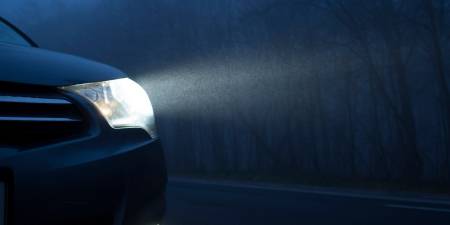Winter is particularly challenging for drivers: the mornings stay dark for longer and the evenings draw in sooner. Fog, rain or snowfall hamper visibility. To avoid endangering yourself or other road users, you should always adapt your driving style and headlight use to the visibility and conditions. We bring light to the darkness.
You are here:
Proper headlight use
In the dark, fog or snow – driving in poor visibility is challenging. This makes it all the more important that you use your headlights correctly and check them regularly.

Correct headlight use
Use of headlights is mandatory – including during the day. Failure to comply will result in a fine. But how should you use them in particular situations?
-
Dipped headlights should be used not only at night or in poor light, but also during heavy rain, snowfall and fog. Daytime driving lights are far too weak and they also operate without rear lights. This makes them hard for others to see – if at all.
-
In the event of poor visibility, turn on your full beam headlights. In built-up areas, when driving in traffic, reversing, near pedestrians, approaching oncoming vehicles, or at level crossings, you must switch to dipped headlights immediately to avoid dazzling anyone.
-
Use fog lights only in the event of poor visibility due to fog, snow or heavy rain. They should never be used in the event of good visibility. Due to their brightness, incorrect use can be dangerous.
-
Use your parking lights when stationary in the dark (for example, when parked next to the road, at level crossings or light signals) or when parking your vehicle in the dark.
Checking your lights
Regularly check the front and rear lights on your vehicle. You can check all light functions for yourself:
Checking the rear lights
First test the brake lights. Reverse towards a (preferably light-coloured) wall and then step on the brake. In your rear-view mirror, you should be able to see red lights shining on the wall on both sides. Now engage the reverse gear. Two points of white light should now appear on the wall. When you switch on the rear fog lights, you should also see one or two bright red dots. These can both vary depending on design.
Checking the front lights
Position your vehicle a few meters in front of a wall, facing towards it. You can now test your dipped and then full-beam headlights. The transition is very obvious, as the light from the full beam headlights appears higher up on the wall. Now drive close to the wall. Provided it is not too bright, you should now be able to see your daytime driving lights. The fog lights appear under the main headlights.
Replacing defective lights
If one or more of your lights are defective, they must be replaced immediately. If you replace your headlights yourself, for safety reasons, have them checked by a specialist. The slightest misalignment can significantly reduce the range of the headlights or cause them to dazzle other motorists. If you notice oncoming motorists start flashing their headlights at you, then you should urgently have your headlight configuration checked.
Insure against glass breakage
Of course, broken glass must be replaced immediately. Replacing broken or damaged headlights, rear lights, indicators, bulbs and LEDs can get expensive. PostFinance car insurance provides an additional option to cover glass breakage.
